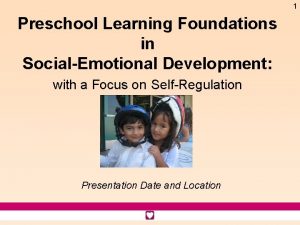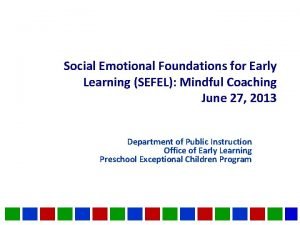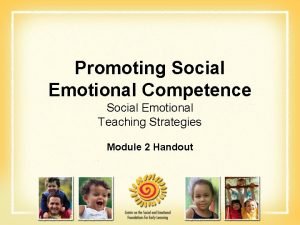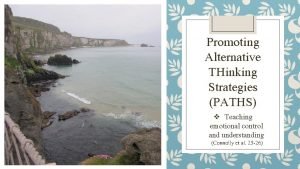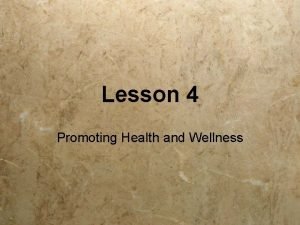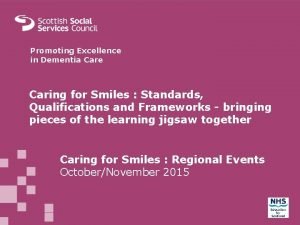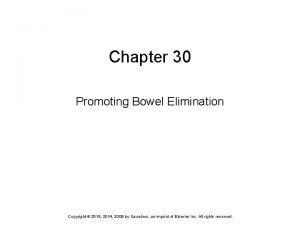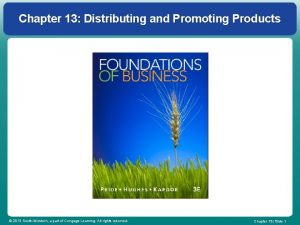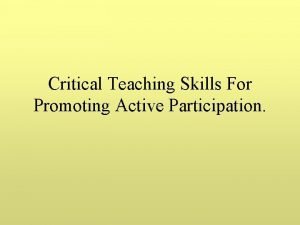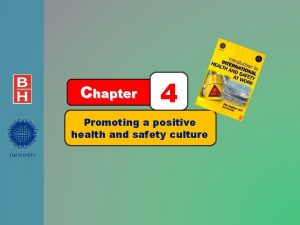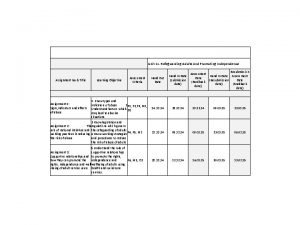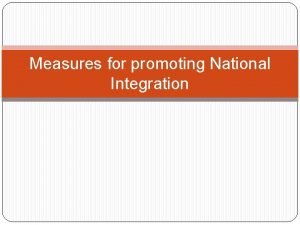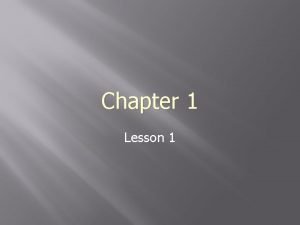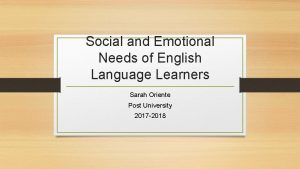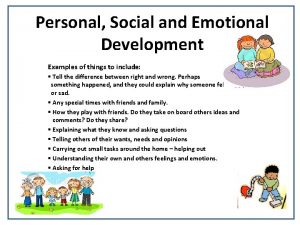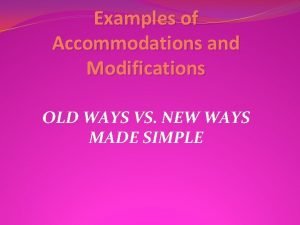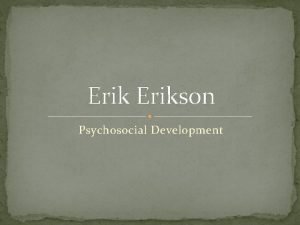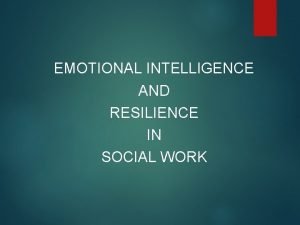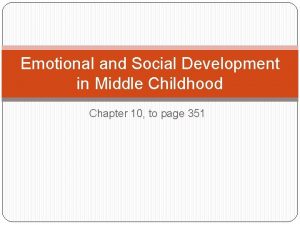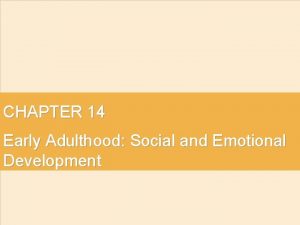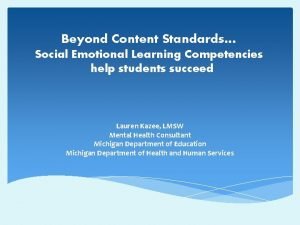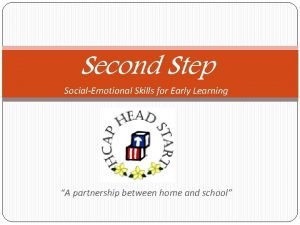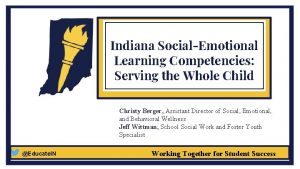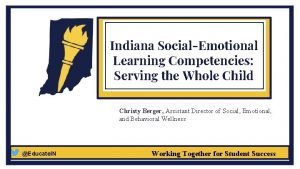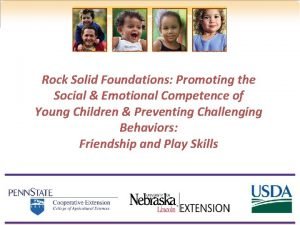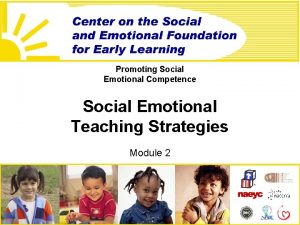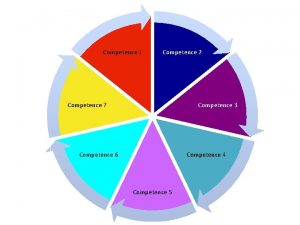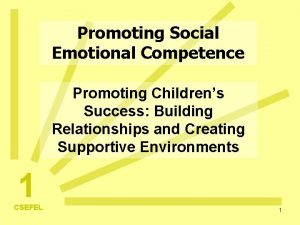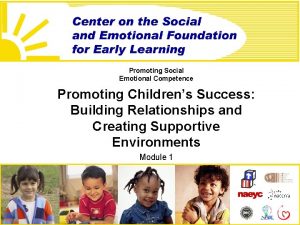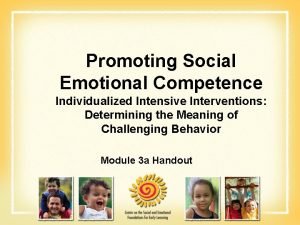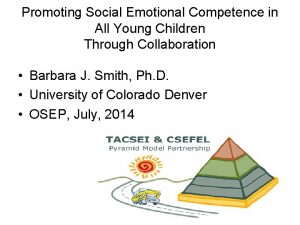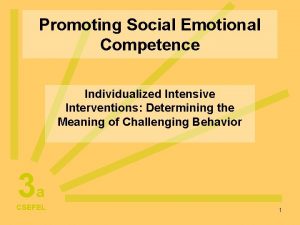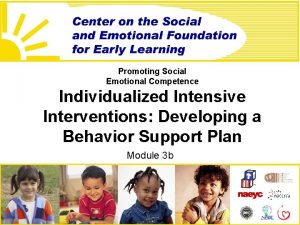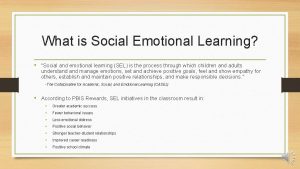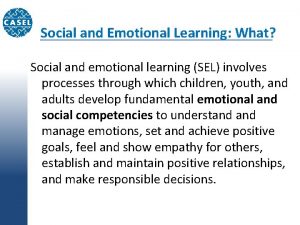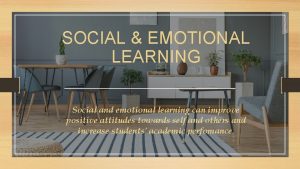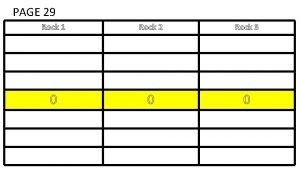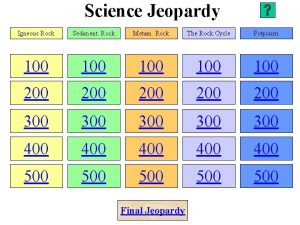Rock Solid Foundations Promoting the Social Emotional Competence




































































- Slides: 68

Rock Solid Foundations: Promoting the Social & Emotional Competence of Young Children & Preventing Challenging Behaviors: Enhancing Emotional Literacy

Introductions 1. Your name, program. 2. What is your role? 3. What will you do with the information you will learn today? INSERT PICTURE OF STATE WHERE DOING TRAINING 2

CYTTAP Allison Silberber, 2007

Promote Children’s Success • Create an environment where EVERY child feels good about coming to school • Design an environment that promotes child engagement • Focus on teaching children what To Do! • Teach expectations and routines • Teach skills that children can use in place of challenging behaviors 4

CSEFEL Pyramid Model 5

Definitions, Research and Rationale 6

CSEFEL Definition of Social Emotional Development The term social emotional development refers to the developing capacity of the child from birth through five years of age to form close and secure adult and peer relationships; experience, regulate, and express emotions in socially and culturally appropriate ways; and explore the environment and learn - all in the context of family, community, and culture. Caregivers promote healthy development by working to support social emotional wellness in all young children, and make every effort to prevent the occurrence or escalation of social emotional problems in children atrisk, identifying and working to remediate problems that surface, and, when necessary, referring children and their families to appropriate services. Adapted from ZERO TO THREE, 2001 HANDOUT: IT 1. 2 7

What is Social-Emotional Development? The developmentally and culturally appropriate ability to: Manage Emotions Relate to Adults Relate to Peers Feel Good About Self 8

Emotional Literacy Emotional literacy is the ability to identify, understand, and express emotions in a healthy way.

Emotional Literacy… …. is the capacity to recognize, label, and understand feelings in self and others. Adapted with permission, Cradling Literacy, 2007 10

Children with a Strong Foundation in Emotional Literacy: • tolerate frustration better • get into fewer fights • engage in less destructive behavior • are healthier • are less lonely • are less impulsive • are more focused • have greater academic achievement 11

Four Strategies to Develop Emotional Literacy 1. Using the adult/child relationship to expand an individual child’s awareness of his emotions or feelings 2. Finding opportunities in the group setting to talk about feelings 3. Using enriching language tools 4. Modeling positive relationships 12

Strategies to Develop Emotional Literacy 1. Using the adult/child relationship to expand an individual child’s awareness of his emotions or feelings: a) Verbally acknowledging and labeling emotions expressed by children in care b) Assisting children with regulating their emotions c) Talking about the fact that feelings can change d) Using questions about feelings to see if a child can respond 13

Strategies to Develop Emotional Literacy 2. Finding opportunities in the group setting to talk about feelings: a) Taking advantage of teachable moments when children experience difficulties with peers and need adult support to resolve them b) Staying close to support children in difficult encounters with other children 14

Strategies to Develop Emotional Literacy 2. Finding opportunities in group settings to talk about feelings: (cont. ): c) Showing positive feelings for both children in conflict d) Letting children know through your calm approach that conflict is to be expected and it can be resolved with help e) Helping children learn to put into words how they think others are feeling and to express empathy for those feelings f) Encouraging negotiating so that each child feels that she/he has been heard and that their feelings have been taken into consideration g) Clarifying rules 15

How is this teacher supporting emotional literacy? I/T

Strategies to Develop Emotional Literacy 3. Using enriching language tools: a) b) c) d) Choosing books, music, finger plays with a rich vocabulary of feeling words Using puppetry or felt board stories that retell common social experiences and that emphasize the feeling vocabulary and conflict resolution Reading stories about characters that children can identify with who express a range of feelings Encouraging toddlers to draw pictures of their difficult or scary emotions 17

Strategies to Develop Emotional Literacy 4. Modeling Positive Relationships a) b) Between adults in the care setting With other children The preceding strategies adapted with permission rom Im, Osborn, Sanchez, & Thorp, 2007 18

ACTIVITY: “Table Talk” With your table mates… Think about preschool children …. . write a list of feeling words that you would most want to teach the children you work with 19

Enhancing Emotional Literacy for Preschool Children… A. B. C. D. Direct Teaching Indirect Teaching Use of Songs and Games Use of Children’s Literature 20

A. Direct Teaching of Feeling Vocabulary 21

English/ Spanish 22

Example 23

B. Indirect Teaching • Provide emotional labels as children experience various affective states - “Tamika and Tanya seem really happy to be playing together! They keep hugging each other!”

C. Use of Songs and Games Sample Song • If you are happy and you know it…add new verses to teach feelings – – – If you’re sad and you know it, cry a tear, ”boo hoo” If you’re mad and you know it, use your words “I’m mad” If you’re scared and you know it, ask for help, “help me” If you’re happy and you know it, hug a friend If you’re tired and you know it, give a yawn 25

Sample Game • How does your face look when you feel proud? • What makes you feel proud?

Sample Game Make a _____ face.

Sample Game 28

Play: How Would You Feel If? • Discuss typical situations that happen when children are together: “How would you feel if this happened to you? ” Ex. : Jeremy wanted to play ball with Katie and Wu-ying today, but they wouldn’t let him. How do you think that made him feel? How do you think you would feel if that happened to you? What could Jeremy try next time? 29

Checking In How do you feel today? • Teachers and children can “check in” each morning by choosing a feeling face that best describes their affective state and putting it next to their name. Children can be encouraged to change their feeling faces throughout the day as their feelings change. 30

Feeling Dice/Feeling Wheel 31

Emotional Literacy Activities 32 PS

D. Use of Children’s Literature

Book Example On Monday When it Rained by Cherryl Kachenmeister Disappointed Embarrassed Proud Scared Angry Excited Lonely 34

Book Nooks – Handout PS 2. 4 http: //www. csefel. uiuc. edu/practical-ideas. html On Monday When it Rained Glad Monster Sad Monster Hands Are Not for Hitting 35 2. 4

On Monday When It Rained Book Nook Activity Example “I feel excited when I get to go to my friend Coby’s house to play. ” “I feel upset when my mommy didn’t get me anything. ” 36

Discussion: Children’s Literature 1. Break into small groups 2. How would you use this book to support social emotional development during large group/story time? 3. How would you plan for activities to support the skills presented in this story? 37

Characteristics That Foster Emotional Literacy 1. Books about feelings are read and available in story center 2. Photos of people with various emotional expressions are displayed 3. Adults label their own feelings 4. Adults notice and label children’s feelings 5. Activities are planned to teach and reinforce emotional literacy 6. Children are reinforced for using feeling words 7. Efforts occur daily 38

Children with a Strong Foundation in Emotional Literacy: • Tolerate frustration better • Get into fewer fights • Engage in less destructive behavior • Are healthier • Are less lonely • Are less impulsive • Are more focused • Have greater academic achievement 39

Emotion Regulation and Problem Solving for ages 2 ½ - 5

Managing Anger and Impulse • Recognizing that anger can interfere with problem solving • Learning how to recognize anger in oneself and others • Learning how to calm down • Understanding appropriate ways to express anger 41

Emotion Regulation Teach children how to “calm down” 3 deep breaths, blow out the candles Webster-Stratton, 1990 42

Relaxation Thermometer Code words: Chill out, cool down Code red, hot engine Adapted from Incredible Years Dinosaur School Take 3 deep breaths… 1. . 2. . 3

Turtle Technique Recognize that you feel angry. Go into shell. Take 3 deep breathes. And think calm, coping thoughts. “Think” Stop. Come out of shell when calm and think of 44 a solution.

Tucker Turtle Takes Time to Tuck and Think A scripted story to assist with teaching the “Turtle Technique” By Rochelle Lentini March 2005 Created using pictures from Microsoft Clipart® and Webster-Stratton, C. (1991). The teachers and children videotape series: Dina dinosaur school. Seattle, WA: The Incredible Years.

Tucker Turtle is a terrific turtle. He likes to play with his friends at Wet Lake School. 46

But sometimes things happen that can make Tucker really mad. 47

When Tucker got mad, he used to hit, kick, or yell at his friends. His friends would get mad or upset when he hit, kicked, or yelled at them. 48

Tucker now knows a new way to “think like a turtle” when he gets mad. 49

He can stop and keep his hands, body, and yelling to himself! 50

He can tuck inside his shell and take 3 deep breaths to calm down. 51

Tucker can then think of a solution or a way to make it better. 52

Tucker’s friends are happy when he plays nicely and keeps his body to himself. Friends also like it when Tucker uses nice words or has a teacher help him when he is upset. 53

Problem Solving Preschool-age children can effectively be taught problem-solving skills (Shure & Spivack, 1980, 1982; Webster-Stratton & Hammond, 1997).

Problem Solving Steps Step 2 Would it be safe? Would it be fair? How would everyone feel? 55

Help the Child Think of a Possible Solution: • Get a teacher • Ask nicely • Ignore • Play • Say, “Please stop. ” • Say, “Please. ” • Share • Trade toys/item • Wait and take turns 56

The Solution Kit 57

Problem Solving TALKING FEET 1. Learning problem solving steps 2. Thinking of alternative solutions 3. Learning that solutions have consequences 4. Learning to evaluate solutions *Is it safe? *Is it fair? *Will it create good feelings? 5. What to do when a solution doesn’t work 58

Problem-Solving Activities • Problematize everything – “We have 6 kids at the snack table and only one apple. We have a problem. Does anyone have a solution? ” • Play “What would you do if…? ” • Children make their own “solution kits” • Children offer solutions to problems that occur in children’s stories 59

Supporting Young Children with Problem-Solving in the Moment 1. Anticipate problems 2. Seek proximity 3. Support 4. Encourage 5. Promote 60

Pulling it all Together! 61

Major Messages to Take Home • Caregivers help children express emotion; develop emotional regulation; and form close, secure relationships • It is important to be intentional about supporting the social emotional competence of children 62

Major Messages to Take Home • In order to support the social emotional wellness of young children, as well as their families, we need to be aware of our own emotional history. • Social emotional literacy is a prerequisite to the development of more advanced social skills and for the continued maturation of emotional self- regulation 63

If there is anything that we wish to change in the child, we should first examine it and see whether it is not something that could better be changed in ourselves. Carl Jung – psychiatrist 64

Be the change you wish to see in the world. Mahatma Ghandi Review your Personal Action Plan 65

Resources • Childcare and Youth Training and Technical Assistance project: http: //www. extension. unl. edu/web/child/cyttap • Better Kid Care: http: //betterkidcare. psu. edu/ • CSEFEL : http: //csefel. vanderbilt. edu/ 66

Evaluation 67

beaucoup s k n a Th ¡Gracias! ﺷ ﻜ ﺮﺍ 68
 Preschool learning foundations volume 1
Preschool learning foundations volume 1 Sefel training
Sefel training Igneous vs sedimentary or metamorphic
Igneous vs sedimentary or metamorphic Emotional competence
Emotional competence The great awakening laid the social foundations for the
The great awakening laid the social foundations for the How can one type of rock change into another type of rock?
How can one type of rock change into another type of rock? Igneous rocks metamorphic rocks and sedimentary rocks
Igneous rocks metamorphic rocks and sedimentary rocks Adventure sports bungee jumping
Adventure sports bungee jumping Chapter 3 standardized test practice answers
Chapter 3 standardized test practice answers A rock climber's shoe loosens a rock and her climbing buddy
A rock climber's shoe loosens a rock and her climbing buddy Metamorphic igneous and sedimentary rock cycle
Metamorphic igneous and sedimentary rock cycle Solid rock precast
Solid rock precast Rocks
Rocks Shallow print or mark in solid rock
Shallow print or mark in solid rock Lynette lin
Lynette lin Asus slogan
Asus slogan Minerals vs rocks
Minerals vs rocks Solid rock cycles
Solid rock cycles Crystalline vs amorphous
Crystalline vs amorphous Solution solid
Solution solid Covalent molecular and covalent network
Covalent molecular and covalent network Crystalline vs non crystalline
Crystalline vs non crystalline Crystalline solids
Crystalline solids Crystalline solid and amorphous solid
Crystalline solid and amorphous solid Anisotropic
Anisotropic When a solid completely penetrates another solid
When a solid completely penetrates another solid Interpenetration of solids
Interpenetration of solids Sifting separating mixtures
Sifting separating mixtures Promoting moral improvement
Promoting moral improvement Promote service arrange decide
Promote service arrange decide Promoting alternative thinking strategies
Promoting alternative thinking strategies Glencoe health and wellness
Glencoe health and wellness Promoting family earthquake preparedness
Promoting family earthquake preparedness Chapter 1 understanding health and wellness lesson 4
Chapter 1 understanding health and wellness lesson 4 Promoting racial literacy in schools
Promoting racial literacy in schools Lesson 4 promoting health and wellness
Lesson 4 promoting health and wellness Methods of promoting intrapreneurship leaving cert
Methods of promoting intrapreneurship leaving cert Keeping an infant safe and well section 7-3
Keeping an infant safe and well section 7-3 Promoting excellence in dementia care
Promoting excellence in dementia care Deontological theories
Deontological theories Chapter 7 promoting health and wellness
Chapter 7 promoting health and wellness Promoting bowel elimination
Promoting bowel elimination Chapter 13 distributing and promoting products
Chapter 13 distributing and promoting products Promoting services and educating customers
Promoting services and educating customers Health promoting schools model
Health promoting schools model Active participation strategies
Active participation strategies Promoting a positive health and safety culture
Promoting a positive health and safety culture Unit 11 safeguarding adults and promoting independence
Unit 11 safeguarding adults and promoting independence Need of national integration
Need of national integration What is institutional support to entrepreneurship
What is institutional support to entrepreneurship Health promoting school
Health promoting school Japan's principal asset in promoting development is
Japan's principal asset in promoting development is Chapter 1 lesson 4 promoting health and wellness
Chapter 1 lesson 4 promoting health and wellness Social thinking and social influence in psychology
Social thinking and social influence in psychology Social thinking social influence social relations
Social thinking social influence social relations Social emotional assets and resilience scales pdf
Social emotional assets and resilience scales pdf Social emotional needs of ell students
Social emotional needs of ell students Personal social examples
Personal social examples General to specific words examples
General to specific words examples Generativity stage
Generativity stage Emotional resilience in social work
Emotional resilience in social work Social and emotional development in middle childhood
Social and emotional development in middle childhood Middle adulthood emotional development
Middle adulthood emotional development Social development in early adulthood
Social development in early adulthood Social emotional learning standards michigan
Social emotional learning standards michigan Second step social emotional skills for early learning
Second step social emotional skills for early learning Social emotional learning standards nj
Social emotional learning standards nj Indiana social emotional learning
Indiana social emotional learning Indiana department of education social emotional learning
Indiana department of education social emotional learning
